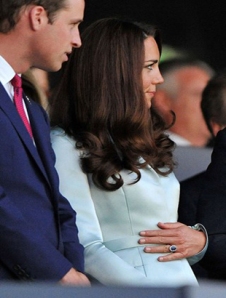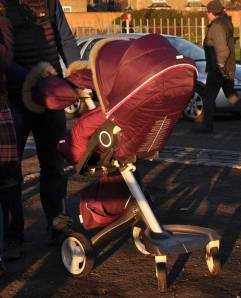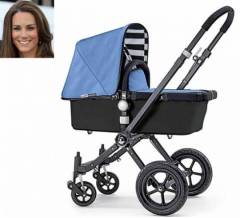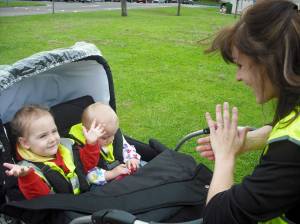 In a few days time, Kate and William are set to become the most famous parents in the world. And when they walk out with the royal baby, they will be doing so in a Bugaboo stroller.
In a few days time, Kate and William are set to become the most famous parents in the world. And when they walk out with the royal baby, they will be doing so in a Bugaboo stroller.
For those of you who missed this announcement, it was casually made on St Patrick’s Day at a reception for army wives. Kate commented to some of those gathered that she had chosen a Bugaboo, also letting slip that she had settled on a light blue colour scheme. This has led many commentators to conclude that we are all expecting a boy.
Four months on, news of the couple’s transport choice continues to circulate within the media. One of the most recent mentions is that in the New York fashion magazine, The Cut. Amongst the many others are discussions about whether the choice of a non-British brand was unpatriotic, and the Guardian’s retrospective on how Bugaboo’s Dutch designer, Max Barenburg, transformed his 1994 student project into a global company that, by 2011, had an annual turnover of £70 million.
Those of you who know my interest in buggies will not be surprised to learn I have followed these media stories with interest. I have watched to see whether any of them link their story of strollers to child development. While it has been pointed out that a Bugaboo is a departure from the Silver Cross strollers of previous royal childhoods, Kate’s choice is not surprising, given that the Bugaboo has become a style icon, popular amongst celebrities. But, no, not one of the articles I have been monitoring has linked strollers to children’s development. (If anyone knows of an article that I have missed, please do let me know.) This means that, despite all the information that is now available about infant neuroscience, we have not yet grappled as a society with the fact that buggies will be shaping the growth of babies’ brains.
How could that be? Is my use of the term ‘fact’ too strong? It is certainly the case that we have virtually no empirical evidence about the impact of buggies on babies’ development, and especially on emotional health. I certainly wish we had more, for that would have meant that the scientific field had shown as much curiosity about devices including buggies, car seats and travel systems as it has done for slings. The (positive) effects of slings are the only data we have in any depth. That’s my key point in this blog: there is no movement blossoming for a ‘science of infant transport’, despite the fact that buggies are now cultural norms. So do we need to wait until we have robust data sets to raise questions about design? Answer: No.
As helpful as data would be, we do not need specific empirical evidence about buggies before we can talk seriously about them. We know beyond a shadow of a doubt that social interaction dramatically shapes children’s brains, and that buggy design frames the kinds of social interaction that babies can have with the pusher. So buggies, brains, and child development have to be linked. If a baby faces outward, then she cannot see, or often even hear, the parent who is pushing him. If the height of a stroller’s seat is close to the ground (as is true for almost all strollers), the baby’s view of the world will include knees, shopping bags, and vehicle tires, which means they aren’t sharing the view that the taller pusher sees. And if a baby gets anxious about the loud, busy, unfamiliar world into which he or she is being thrust, he/she will get more anxious until reassurance is on offer, which can only be found in the attentive presence of someone whom the baby trusts.
Why is social interaction so terribly important for babies? The answer is that babies come pre-wired for it. The physiological connection between babies and parents is nothing short of amazing. For example, babies can read the emotional expression on a parent’s face long before they can talk, and they use that expression to work out whether something in their own world is safe or dangerous. Babies are calmed simply by hearing their parent’s voice, and if they are picked up in response to crying, their heart rate immediately begins to slow down. When a baby sleeps next to his mother, the physiological systems of the pair become synchronised, with breathing rates, heart rates, and sleep cycles matched.
In case anyone thinks I have a hang up about buggies being somehow extra special for development, let me make clear I don’t. Buggies are only one of many activities that shape parent-infant interaction. Sleeping, feeding, playing, bathing, talking, singing, shouting, laughing, and all the others count too. Everything that happens to a baby is shaping brain development, because neural pathways are being formed every single second by every single activity. Never again in life will synaptic connections in the brain be created so rapidly as the period up to 3 years of age. Every time a baby has a repeated experience, the neural pathways associated with that experience are strengthened (through a process called myelination.)
My hang up about buggies comes from the fact that science and regulators have given so little attention to them. Of all the activities I just named, transportation devices such as buggies have received the least consideration in the scientific literature. This is despite the fact riding in them is one of the things that almost all babies these days will have daily experience of. Babies in the UK apparently spend an average of 2 hours per day in a buggy, with this stretching up to 5 hours or more for some children. A lot of synapses are formed in 2 hours a day x 7 days a week.
 This neglect continues despite my own efforts to work with manufacturers and retailers such as Stokke, Gracco, and Mothercare. Respected educational bodies, such as the National Literacy Trust and The Sutton Trust have also given buggies serious attention. Other professionals have too, including Sally Goddard Blythe, who is concerned about the possible impact of today’s strollers on crawling and motor development, and Leigh Wilson, who wonders how the contemporary penchant for placing a blanket over a pram may affect a baby’s breathing. The thoughts of the highly respected Elizabeth Jarman, regarding the impact of colour and texture of a stroller’s fabric, probably sound laughable, until you understand the basics of brain development.
This neglect continues despite my own efforts to work with manufacturers and retailers such as Stokke, Gracco, and Mothercare. Respected educational bodies, such as the National Literacy Trust and The Sutton Trust have also given buggies serious attention. Other professionals have too, including Sally Goddard Blythe, who is concerned about the possible impact of today’s strollers on crawling and motor development, and Leigh Wilson, who wonders how the contemporary penchant for placing a blanket over a pram may affect a baby’s breathing. The thoughts of the highly respected Elizabeth Jarman, regarding the impact of colour and texture of a stroller’s fabric, probably sound laughable, until you understand the basics of brain development.
I get lots of letters from parents and grandparents, telling me lovely stories about their buggy choices. And I know of childcare settings, such as VIP Childcare, in Elgin, Scotland, who feel that they have improved the care they offer children by buying double buggies that face the pusher, despite the increased cost of such models. But these are not enough for me! So I thought that the story of our royal parents-to-be presented a new opportunity to try again.
Therefore, let me shout it in bold letters: The buggy that Kate and William have chosen will shape the brain of the future King. (Why a king, you ask? It might be a girl. Yes, that’s true, but why not just go ahead and take the colour choice as a tip-off? Its one of the many pieces of evidence that are being used internationally by bookies to offer odds on everything from the baby’s sex to the name to the likely date of birth to hair colour.)
Do the Duke and Duchess of Cambridge know about the importance of their buggy choice? I don’t know. I have this week taken the liberty of sending them a letter with this information, hoping that it might reach them, via the circuitous route through their staff.
I have done this because it is not just their baby I am thinking about, although I do wish them much joy and fun. I am thinking about all the babies whose development can be boosted through Kate and William’s awareness of this information. Their baby is about to be the most famous baby in the world. In the months and years to come, we will all be peppered with photographs of the royal baby being transported in that Bugaboo.
If Kate and William are photographed with the buggy oriented so that the baby faces them, then millions of parents will follow suit. If they are photographed talking to the baby while in that stroller, then millions of parents will follow suit. If they happen to be photographed sometimes wearing a sling to carry the baby in, then millions of slings will sell out too. (Especially if its William wearing the sling!) And if they were, per chance, to mention in any speeches they deliver that they were learning about the ways that strollers and everything else is influencing their baby’s brain development, then millions of parents will have the chance to listen. Because the media can be counted on to report everything they say and do.
Buggies matter – as does everything else in a baby’s day. After mid-July, Kate and William, and Bugaboo and Max Barenburg, will have a once-in-a-global-lifetime’s opportunity to help the world understand this.




Hi Suzanne
Great blog, yes more parents are purchasing prams that face towards the parent, in order to stimulate conversation, etc.
However, I have observed parents pushing prams and talking away on their mobile phones and/or talking to someone else, therefore ignoring the baby/toddler completely.
I think our discussions need to be with parents in how they communicate
with their babies and toddlers and how when pushing a pram, is a key moment to have those amazing, parent and baby times.
I deliver workshops for parents on effective communication with their child and include, how not to miss opportunities, when pushing their babies in prams.
In addition, one of the subject areas that have been discussed is the colour scheme and furniture in Prince George’s nursery. When my son’s where born they slept in a ‘Moses basket’ next to me.
In short, much work needs to be done in promoting close attachments between parent and child and the impact on brain development.
Keep up the good work.
Laura
LikeLike
Laura
The more information we can provide to parents (and grandparents and nursery staff and anyone else interested in babies) about what we now know about babies innate capacities for connection, the more I think that will empower them to think through all sorts of activities, including mobile phones.
You are spot on in saying that it isn’t buggies per se, it is how we use them. Like everything else in babies’ lives. (I think really understanding this is scary for most of us.)
Great to hear from you, Laura.
Suzanne
LikeLike
You didn’t mention that VIP in Elgin also use slings and wraps for carrying the children they care for. One of the reasons why the babywearing community mainly use this nursery. Unfortunately I couldn’t get my son into it as was fully subscribed when I moved here. Shame more Childcare centres don’t use them when so many parents nowadays do.
LikeLike
Hi there Rach, yes VIP Childcare currently are using slings to enhance our attachments and sense or security with our babies and so far has been a success with our babies, our team and parents are happy to see their child feeling content to explore their new environment with their key worker too.
With regards to your post about availability we can update your enquiry to see if any upcoming spaces become suitable for you and your son in addition we have other methods of becoming active with VIP’s social impact such as our ABC group – promoting the importance of early years in the community and also we have a very active Parent’s forum if you wish for more information please do not hesitate to contact us – for the baby team please email Babyunit@vipchildcare.co.uk.
We are very interested in Suzanne’s Journey to promote early years development and attachments and what an excellent vehicle to pursue this message with the focus on the expecting Royal couple – warm wishes on your mission Suzanne *Hugs*
LikeLike
I got an expensive buggy which was useless, a cheaper one which was much easier to use but faced outwards which I wasn’t keen on so I ditched them for a sling 🙂 Hope Kate carries her baby 2 🙂 much easier and the child gets to see the world as we see it and not knees, bags and tyres……..
LikeLike
I heard rumours Kate did receive a sling from Oscha Baby, so let ‘s hope the baby will be carried!!
LikeLike
thank you Lisa for that comment, yes she should be carried, that is what the baby’s brain needs to develop a trusting relationship that will accompany a life time of healthy relationships.
LikeLike
But in addition to being carried, and also very significant for shaping early infant brain development as well as building trust, is that babies from birth must be given the time and space to continue something they were pursuing inside the womb — movement! Research shows babies change their positions frequently when they have freedom of movement. If you want to see how critical these choices are, check out the new educational dvd at http://www.rie.org titled “See How They Play”
LikeLike
That’s interesting. I knew instinctively when my baby was born that I wanted him as close to me in height as possible and definitely facing me. But I have never thought about colour and texture and what influence those might have. Where can I find out more?
LikeLike
Christina. I’m delighted that my comments have proved helpful. No one has thought about colour. Its just an avenue we haven’t thought about yet — but I hold hopes we soon will! If you go to Elizabeth Jarman’s website (as linked in the blog), you’ll find out a lot more about colour and texture. Elizabeth’s work is not about buggies specifically, but about environments. Of course, when a child is in a buggy, that is a key element of his/her environment… You’ll find some comments specifically about buggies on her Facebook page. Yours, Suzanne
LikeLike
Christina. I spoke too quickly there. Its obviously not the case that ‘no one’ has thought about colour. Elizabeth Jarman has! What I meant to say was that if general design features, such as height and orientation, are not part of our general societal considerations about the impact of buggies on infant health, then it is no surprise at all that texture and colour would be considerations. I’m so delighted that you have picked this up as an important theme from this most recent blog. We need so much more discussion about babies’ experiences.
LikeLike